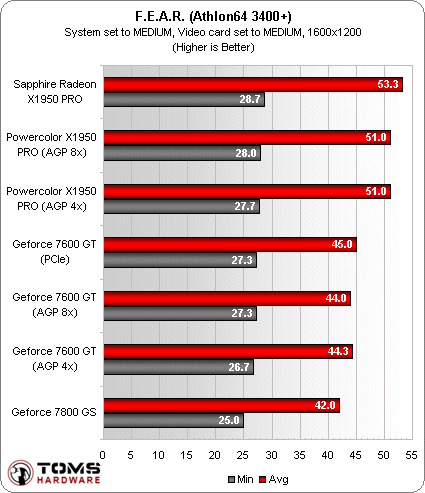AGP Platform Analysis, Part 2: New Cards, Single-Core System
F.E.A.R
Because the F.E.A.R. engine showed different results at every resolution in Part 1 of the AGP analysis, we chose to use it as a demonstration of how much of a bottlenecking effect the AGP or PCIe interface might have. We tested the X1950 PRO and 7600 GT at both 8x AGP and 4x AGP, set in the motherboard BIOS. Additionally, we tested our PCI express 7600 GT to see if the PCIe interface would have an effect (regrettably, we could not secure an X1950 PRO PCIe in time for testing, but we hope to revisit this test in the future).
Without further a due, here are the results from the Athlon64 3400+:

Clearly, at the low 1024x768 resolution, the interface is not coming into play. Indeed, across all cards and resolutions the platform seems to be setting the speed as all cards perform similarly. Let's see what happens when we increase resolution to 1600 x 1200:

Now we are seeing the beginnings of separation in the pack, although this has nothing to do with AGP 4x, 8x and PCIe which perform identically in the 7600 GT. We are seeing the X1950 PRO pulling ahead because the resolution is beginning to tax the video cards. Let's sprinkle in some anti-aliasing and anisotropy to tax the video cards even more:

Once again, even at 1600x1200 with 4xAA and 8xAF, there is no difference between AGP 4x, 8x and PCI express in the 7600 GT cards. While the X1950 PROs show their muscles, there is no notable difference between the frame rates at 4x AGP or 8x AGP. Honestly, I expected to see some bottlenecking at this resolution between 4x AGP and 8x AGP. The AGP speed was set in the motherboard BIOS and there's no way of ensuring the switch was working properly, but there's no arguing with the 7600 GT AGP and PCI express similarity - they were separate cards using separate slots.
Stay on the Cutting Edge
Join the experts who read Tom's Hardware for the inside track on enthusiast PC tech news — and have for over 25 years. We'll send breaking news and in-depth reviews of CPUs, GPUs, AI, maker hardware and more straight to your inbox.
Most Popular

